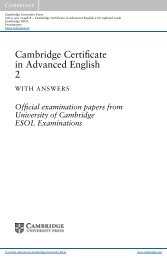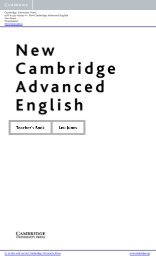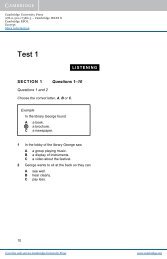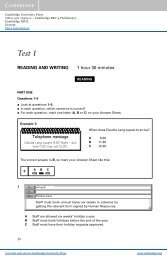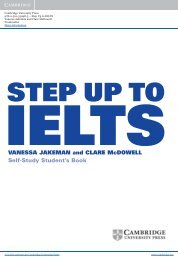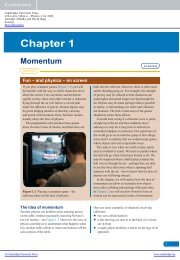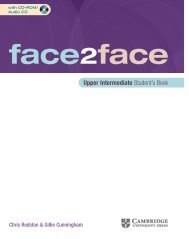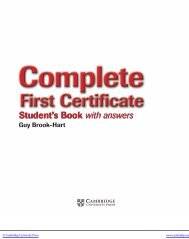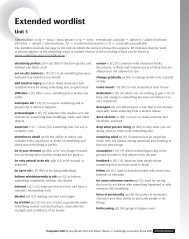Skills for Study Level 2 Teacher's Book - Cambridge University Press
Skills for Study Level 2 Teacher's Book - Cambridge University Press
Skills for Study Level 2 Teacher's Book - Cambridge University Press
Create successful ePaper yourself
Turn your PDF publications into a flip-book with our unique Google optimized e-Paper software.
4eSuggested answers1Presents factual data about historical uses of leeches, using non-integralcitations which suggests that the author is certain about this. The author isless certain about the claims <strong>for</strong> the numbers of leeches used in London andParis. The writer then presents a number of modern-day uses of leeches,again seeming to accept the in<strong>for</strong>mation without question. Finally they endby considering the reasons <strong>for</strong> the revival of medical leeching. The author isless certain here because they only point out what supporting sources have‘suggested’ may be the reason.2Presents factual / biographical data about certain Arab and Persian medicalpioneers, seemingly without question, and also seems to accept the claim byCameron that Persian scholars are often treated as ‘Arabs’ <strong>for</strong> having writtenin Arabic. The writer also seems to accept Gorji and Ghadiri’s claims about theuse of Avicenna at the <strong>University</strong> of Brussels. The writer ends by using Gorjiand Ghadiri to support a claim that Persian physicians introduced many newscientific theories. By writing ‘As Gorji and Ghadiri have observed ...’, it seemsthat the writer accepts the truth of it.5 Using cautious language <strong>for</strong> your own claims5aSuggested answersNote: ‘Appropriateness’ here is taken to mean cautious language featuring the use ofmodal auxiliaries, adverbs, adjectives, etc., as well as avoidance of absolute terms ingeneral, and use of attributive phrases in citations.1 – Passage b2 – Passage a3 – Passage b5b Students check their answers with a partner.5cSuggested answersNote: In each passage, key terms have been underlined. In the ‘less appropriate’passage of each pair, there<strong>for</strong>e, the underlining denotes words or phrases thatshould be used with care, while in the ‘more appropriate’ passage it denotesalternative phrases which are more cautious.Passage 1aPharmaceutical manufacturing capacity is very restricted: over 92% of all new drugdevelopment takes place in the so-called high-income countries (WHO, 2004, p.5)(not a phrase to be avoided, but compared with the more cautious citationbelow, this is a more direct truth claim). The share of drugs manufactured inthe poor and middle-income countries is decreasing all the time, because thedevelopment of new drugs is a slow and costly process, requiring funding and hightechnology which are beyond the means of all but the largest corporations in thewealthy industrialized nations. This concentration of manufacturing capacity in just afew organizations, however, has serious consequences. The drug companies focuson developing only those medicines which they expect to be profitable, and havingmade them they protect them with commercial patents and charge high prices <strong>for</strong>Unit 3 Part C ∙ Investigating 92



